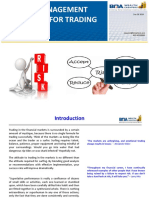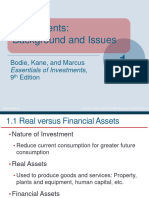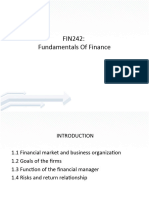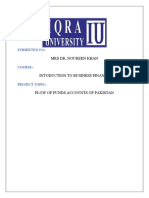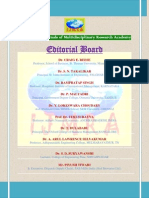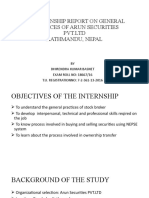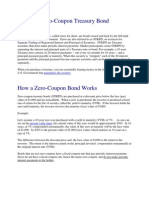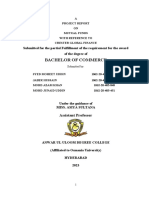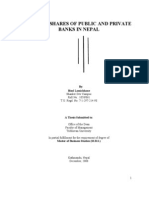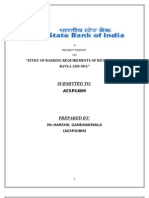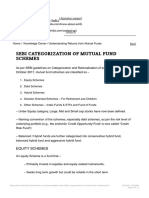1 Introduction
Uploaded by
xyzcompany521 Introduction
Uploaded by
xyzcompany52Security Analysis: An Introduction
Course Handout
What is this course about?
Part 1
• Investment-Philosophy
• Role of financial markets and Indian Investment Environment
• Financial Markets: Method of security Issue, Market structures
Part 2
• Fixed Income Securities i.e. Bond Types and Pricing
• Term Structure of Interest rates
• Portfolio Management of Fixed Income securities
Part 3
Fundamental Analysis
• Economic, Industry and company Analysis
• Correcting expenses misclassification, Accounting earnings Vs True earnings
• Valuation methods i.e. DCF, Comparables, etc.
• Estimation of risk parameters, cashflows, growth rate, etc.
• Measuring equity value
Course Outcomes
The objective of the course is to provide the conceptual foundation to undertake Investment
analysis for securities, both equity and debt.
CO1: Understand the role and structure of financial markets in an economy.
CO2: Analyze fixed-income securities in terms of their characteristics, pricing, yield and yield
curve.
CO3: Analyze risk in fixed-income securities.
CO4: Understand concepts related to economic, industry, and company analysis.
CO5: Apply discounted cash flow method to value companies.
CO6: Apply the relative valuation method to value companies.
Assessment Components
No. Parameter Weightage Conducting on
1 MidTerm 20 End of 10
sessions
2 Group Project 20 Due end of
sessions
3 Class participation (10-Pre+10-Post) 20 10- Pre-Mid
term.
10- Post-Mid
term.
4 Comprehensive Examination 40
Total 100
History of the Discipline
• Benjamin Graham (teacher of Warren Buffett) is credited with starting the discipline of
security Analysis.
• Wrote the book titled “Security Analysis” in 1934.
• “Margin of Safety” the most important principle.
• Investing Vs Speculation
Investment Vs Speculation
Sacrificing something now for the prospect of gaining something later.
"An investment operation is one which, upon thorough analysis promises
safety of principal and an adequate return. Operations not meeting these
requirements are speculative."
Graham & Dodd
Speculation: The activity of forecasting the psychology of the
market.
John Maynard Keynes
Transformation of discipline
• Fundamental Analysis
• Technical Analysis
• Efficient market hypotheses
Investment Environment
In this session we cover the following:
• Role of Financial Markets
• Investment Process
• Saving and Financing statistics for Indian Market
• Trends in the Investment field
What is a Financial Market?
• Place for buying and selling financial assets.
• Provide financing source
• Provide Investment avenue
Why can’t this function be administered by Government or banks or Financial
Institutions?
What would happen in the absence of markets?
• One institution makes the decision about funding or not funding and the
related variables without taking into consideration the views of the participants
(buyers or sellers).
• For example if only banks or Government are the only suppliers of capital, then
a small few officials would decide whether to provide financing or not and also
the rate of financing. This may or may-not consider all the factors. There may
be favoritism or personal biases as well.
• As against the above if a company raises money through a bond market, the
participants can make the individual decision of funding, as well as the amount
and the interest rate. This way it is not based on decision of a few officials like
bank or Government.
Financial Market Role 1
Assume the following:
• A listed oil & Gas company has found a major oil reserve.
• A top official of a listed company has been caught bribing Govt officials.
• In both cases the information will be quickly reflected in prices through increased buy/
sell orders.
• When the investment decision has to be made by wide variety of participants then the
demand or the supply would be based on the information available by all the market
participants.
• In the absence of markets the above information may or may not be considered if decision
is being made by few.
• Thus the market is playing the role of “information aggregation”. Also termed as price
discovery.
Financial Market Role 2
Consider the following
• A 25-year old is earning Rs.2 lakh and consuming just Rs.50,000. He wants to purchase a
house after 5 years.
• A 45-year old also earns more than he spends but want money for post-retirement years i.e.
after 20 years.
• By investing in different instruments for different maturities the above participants may
decide to buy or sell assets based on their requirement.
• Thus the market plays a role of “storing value and helping to transfer consumption to future”.
Financial Market Role 3
• A 20-year old wants to multiply her money fast and is willing to take higher risk. She
invests in a bio-technology company working on wonder drug
• A 60-year old wants to play safe and is fine with lower return. She invests in a utility
company.
• The market participants can choose to invest based on their different risk appetite. The
market performs the role of “risk allocator”.
• As against this if everyone (in the absence of markets) is investing is a bank deposit or
pension scheme of government, they are not able to choose the investment in line with
their risk-return requirement.
Financial Market Role 4
• You think that Real estate business has great future but do not want to start a real estate
company. What can you do?
• You can buy the shares , that represent the business. Each share represent some fraction of
the value. Ownership of the share brings the right but no legal responsibility.
• In the absence of market it is not feasible to raise capital from large pool of investors. The
market in this role helps to separate “ownership from management”
• However this benefit brings with itself the issue of agency cost, wherein the incentives of
owners are not aligned with those of the management.
• A CEO of company would like to run a bigger company rather than a very profitable
company. He may go for acquisitions which may not make economic sense but gives him
more clout. This behavior is unlike the owner who would be more interested in the company
being more profitable rather than being big.
Financial Markets and the Economy
• Information Role: Capital flows to companies with best prospects
• Consumption Timing: Use securities to store wealth and transfer consumption to the
future
• Allocation of Risk: Investors can select securities consistent with their tastes for risk
• Separation of Ownership and Management: With stability comes agency problems
Can you trust Financial Markets?
• Market reflects the mood of its participants. It continues to surprise the participants
who create it.
• In the words of Ben Graham, market is a “manic-depressive” creature given to mood
swings.
• In short term it is voting machine but in long term it is a weighing machine.
• Governments and corporates have tried to control it in the past but have achieved
limited success.
• Use markets for your purpose, fully realizing that it may surprise you anytime.
Attempt the Quiz titled “Role of Markets” in the Socrative.
How?
1. Go to www.b.socrative.com
2. Click on “Login” (top right)
3. Click on “Student Login”
4. Room Name: SAIMTA2023/SAIMTB2023
5. Enter your first Name
Players in Financial Markets
• Firms
• Households
• Government
• Financial Intermediaries
• Banks
• Investment Funds, Insurance companies
Investment Process
• Asset allocation
– Choice among broad asset classes
• Security selection
– Choice of which securities to hold within asset class
– Security analysis to value securities and determine investment
attractiveness
Saving and Financing Statistics
Real Assets Versus Financial Assets
• Real Assets
– Determine the productive capacity and net income of
the economy
– Examples: Land, buildings, machines, knowledge used
to produce goods and services
• Financial Assets
– Claims on real assets
– Fixed Income, Equity, derivatives
Real Asset Vs Financial Asset: Saving of Indian Household
USA households have close to 70% savings in financial assets
80%
70% 67% 65%
62%
59% 60% 59% 60%
60% 58% 57%
51%
50% 48%
40% 41% 39% 40%
39% 39%
40% 37%
31% 33%
30%
20%
10%
2% 2% 1% 2% 2% 2% 1% 1% 1% 2%
0%
2012 2013 2014 2015 2017 2018 2019 2020 2021 2022
Financial Physical Valuable
Source: RBI Annual Reports
Share of Financial Assets of Indian Households
2019-20 2020-21 2021-22
1. Total Deposits (a+b) 37% 40% 27% 6. Small
Savings
(a) Bank Deposits 34% 39% 26% (excluding
(b) Non-Bank Deposits 2% 1% 2% 5. Investments, 1. Total
PPF), 13%
9% Deposits
2. Life Insurance Funds 16% 18% 17%
(a+b), 27%
3. Provident and Pension Funds
(including PPF) 21% 17% 23% 4. Currency,
11%
4. Currency 12% 12% 11% 3. Provident 2. Life
5. Investments 4% 4% 9% and Pension Insurance
Funds Funds, 17%
of which: 0% 0% 0% (including
(a) Mutual Funds 3% 2% 6% PPF), 23%
(b) Equity 1% 1% 2%
6. Small Savings (excluding PPF) 11% 9% 13%
Year: 2021-22
Source: Reserve Bank Of India
Sources of financial resources to the Commercial Sector
2019-20 2020-21 2021-22
A. Adjusted Non-Food Bank Credit 38% 29% 47%
B. Flow from Non-Banks (B1+B2) 62% 71% 53%
B1. Domestic Sources 27% 48% 24%
i) Public & rights issues by non-financial entities 4% 2% 6%
ii) Gross private placements by non-financial entities 15% 18% 8%
iii) Net issuance of CPs subscribed to by non-banks -10% 3% 1%
iv) Systematically important non-deposit taking NBFCs and deposit
taking NBFCs and HFC (net of bank credit) 7% 15% 3%
v) Others 10% 11% 7%
B2. Foreign Sources 35% 23% 28%
i) Foreign Direct Investment to India 26% 25% 19%
ii) Others 10% -2% 9%
C. Total Flow of Resources (A+B) 100% 100% 100%
Capital market fund sources for Companies
APPENDIX TABLE 5: CAPITAL MARKET - PRIMARY
(Amount in ₹ crore)
2021-22 2022-23 (P)
Item
Number Amount Number Amount
1 2 3 4 5
I. PRIMARY MARKET
A. Public and Rights Issues 192 1,50,483.6 272 75,043.9
Issuer Type
(a) IPOs 120 1,12,552.5 164 54,772.4
(b) Listed / NCDs 72 37,931.2 108 20,271.5
B. Euro Issues (ADRs and GDRs) … … … …
C. Private Placement 1,493 6,32,226.7 1,654 8,82,826.2
(i) Equity^ 29 31,438.5 11 8,212.3
(ii) Debt 1,464 6,00,788.2 1,643 8,74,613.9
D. Qualified Institutional Placement 29 31,438.5 11 8,212.3
E. Mutual Funds Mobilisation (Net)# 2,46,729.6 76,225.5
Source: RBI Annual Report 2022-23
Source: RBI Annual Report 2022-23
Investor Profile: % holding of different Investor categories
Trends in Investments
• Globalization
• Securitization
• Financial engineering
• Digital Security
• Cryptocurrency
• ESG Investing
Globalization of Financial Markets
• Companies raising capital across borders i.e. FCCBs and ECBs
• Nifty Index was being traded in Singapore Stock Exchange till June-2023
• Foreign Portfolio Investments account for 20% of the MCAP of India.
• Global stock indexes like Morgan Stanley Capital International (MSCI) have allocated
weightages to many Indian stocks.
Securitization
• Pooling existing loans and creating a security out of it with a face value and
Interest rate.
• Selling this security to investors and earning a fee income.
• Used by banks/financial companies when opportunities for lending are
much more than the capital available.
• Investors attracted to these securities since they provide higher returns
than existing products.
Financial Engineering
• Creation of new financial products to meet investor and issuer needs.
• Principal protection plan: A product where the investor is unlikely to lose the principal
while at the same time have a possibility of uncapped gains.
• Zero coupon bond or convertible securities
Digital Security
• is a representation of financial asset i.e. equity, bond, derivative where investment
contracts are recorded and verified in a block-chain network.
• Helps in achieving transactional efficiency and also obviate the need for clearing and
settlement. Reduces compliance costs.
• Improves liquidity of illiquid investments, say a venture capital investment.
Cryptocurrency
• Not a fiat currency i.e. not issued by sovereign government
• Use decentralized control
• Gaining in prominence. If Bitcoin was a company it would be amongst the top 10
companies in the world.
..ESG Investing
• ESG assets under management are expected to reach to $53 trillion, making up to one-
third of the total assets under management by 2025.
• Exchange traded funds (ETFs) based on ESG are expected to reach $1 trillion AUM by
2025.
• ESG debt is expected to be around $11 trillion by 2025.
Source: Bloomberg
Attempt the Quiz titled “Investment Environment” in Socrative.
How?
1. Go to www.b.socrative.com
2. Click on “Login” (top right)
3. Click on “Student Login”
4. Room Name: SAIMTA2023/ SAIMTB2023
5. Enter your first Name
Rise of Systemic Risk
• Systemic Risk: a potential breakdown of the financial system in which problems in one
market spill over and disrupt others.
– One default may set off a chain of further defaults
– Waves of selling may occur in a downward spiral as asset prices drop
– Potential contagion from institution to institution, and from market to market
Broad Take-home
• Markets play an important role in an economy but they are ruthless both for the
companies (Jet airways, DHFL, IL & FS, other NBFC’s) as well as investors.
• Financial Market includes all kinds of participants, rational as well as emotional (more
emotional) who are acting on information and influencing the value of companies.
• A systematic approach should be adopted to invest and fund through financial
markets.
• Markets are not full proof. If things are not done right they can take the economy
down.
• Be careful of financial intermediaries, they are not Santa Klaus.
You might also like
- Solution Manual For Essentials of Investments 11th by Bodie100% (53)Solution Manual For Essentials of Investments 11th by Bodie6 pages
- Bec Vantage Practice Tests With Key PDFNo ratings yetBec Vantage Practice Tests With Key PDF19 pages
- Third Year Financial Economics 2012 Topic1a1No ratings yetThird Year Financial Economics 2012 Topic1a152 pages
- Chapter 1, 2, 3, 4 Investment Analysis and Portfolio Management SSSSSSNo ratings yetChapter 1, 2, 3, 4 Investment Analysis and Portfolio Management SSSSSS12 pages
- Investments: Background and Issues: Bodie, Kane and Marcus 9 Global EditionNo ratings yetInvestments: Background and Issues: Bodie, Kane and Marcus 9 Global Edition25 pages
- Introduction To Financial Management BM40002: Course Instructor Dr. Devlina ChatterjeeNo ratings yetIntroduction To Financial Management BM40002: Course Instructor Dr. Devlina Chatterjee32 pages
- Unit - I Syllabus: Introduction and Scope of The SubjectNo ratings yetUnit - I Syllabus: Introduction and Scope of The Subject24 pages
- Solution Manual for Essentials of Investments 11th by Bodie - Quick Download In Full PDF Format With All Chapters100% (6)Solution Manual for Essentials of Investments 11th by Bodie - Quick Download In Full PDF Format With All Chapters44 pages
- FINANCIAL MARKETS CHAPTER 1 Elements of InvestmentsNo ratings yetFINANCIAL MARKETS CHAPTER 1 Elements of Investments50 pages
- The Influence of The Strong Economy On Financial Markets: All The Other Organs Take Their Tone."100% (1)The Influence of The Strong Economy On Financial Markets: All The Other Organs Take Their Tone."2 pages
- A Comparative Study On Investment PatterNo ratings yetA Comparative Study On Investment Patter46 pages
- Indian Capital Market: Current Scenario & Road Ahead: Prof Mahesh Kumar Amity Business SchoolNo ratings yetIndian Capital Market: Current Scenario & Road Ahead: Prof Mahesh Kumar Amity Business School44 pages
- Lecture 1 - Introduction To Investment ProcessNo ratings yetLecture 1 - Introduction To Investment Process27 pages
- Unit 1: The Activity of Risking Money On The Result of Something, Such As A Game or Horse Race, Hoping To Make MoneyNo ratings yetUnit 1: The Activity of Risking Money On The Result of Something, Such As A Game or Horse Race, Hoping To Make Money11 pages
- Introduction To Financial Market in India (Role and Importance of Financial Markets)No ratings yetIntroduction To Financial Market in India (Role and Importance of Financial Markets)20 pages
- One Business and Financial EnvironmentsNo ratings yetOne Business and Financial Environments40 pages
- Get full Solution Manual for Essentials of Investments 11th by Bodie free all chapters100% (9)Get full Solution Manual for Essentials of Investments 11th by Bodie free all chapters37 pages
- What Are The Financial Fundamentals?: MoneyNo ratings yetWhat Are The Financial Fundamentals?: Money3 pages
- Chap1 Introduction 94ac847c9ee5d8c92d6cbd13cb447209No ratings yetChap1 Introduction 94ac847c9ee5d8c92d6cbd13cb44720945 pages
- Session 2 Introduction - IAPM 06.06.2024No ratings yetSession 2 Introduction - IAPM 06.06.202412 pages
- FIN72 - Financial Markets Additional Notes SCNo ratings yetFIN72 - Financial Markets Additional Notes SC20 pages
- Roadmap to Cima Gateway Success: Roadmap to help you pass your CIMA Gateway exams - A practical guide: Roadmap to help you pass your CIMA Gateway exams - A practical guideFrom EverandRoadmap to Cima Gateway Success: Roadmap to help you pass your CIMA Gateway exams - A practical guide: Roadmap to help you pass your CIMA Gateway exams - A practical guideNo ratings yet
- An Internship Report On General Practices of Arun Securities PVT - LTD Kathmandu, NepalNo ratings yetAn Internship Report On General Practices of Arun Securities PVT - LTD Kathmandu, Nepal10 pages
- What Is A Zero-Coupon Treasury Bond: Guarantees The SecurityNo ratings yetWhat Is A Zero-Coupon Treasury Bond: Guarantees The Security7 pages
- Chapter-1 Rationale For The Study: Customer Satisfaction With Product & Service of Reliance Mutual Fund100% (2)Chapter-1 Rationale For The Study: Customer Satisfaction With Product & Service of Reliance Mutual Fund58 pages
- Bachelor of Commerce: Submitted For The Partial Fulfillment of The Requirement For The Award of The Degree ofNo ratings yetBachelor of Commerce: Submitted For The Partial Fulfillment of The Requirement For The Award of The Degree of75 pages
- A Comparative Study On Investment Policy of Nabil and Nepal Sbi Bank Ltd.No ratings yetA Comparative Study On Investment Policy of Nabil and Nepal Sbi Bank Ltd.111 pages
- Regulatory Compliance Requirements and Schedule of Reporting For All TRE Certificate Holders100% (1)Regulatory Compliance Requirements and Schedule of Reporting For All TRE Certificate Holders11 pages
- Chapter 3 Interest Rates and Security ValuationNo ratings yetChapter 3 Interest Rates and Security Valuation5 pages
- Banking Requirement of Rice Mills of Bavlca and Npa.No ratings yetBanking Requirement of Rice Mills of Bavlca and Npa.63 pages




